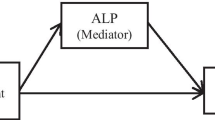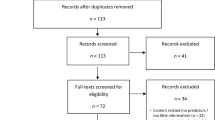Abstract
The aim of the present study was to investigate quality of life (QL) as a predictor of smartphone addiction risk among Turkish adolescents. In line with this purpose, a total of 352 high school students (153 males and 199 females) completed the Pediatric Quality of Life Inventory and a Smartphone Addiction Scale during the 2015–2016 academic year. Simple and multiple linear regression analysis was used to examine the association between QL and smartphone addiction risk. The results of this study suggested that the dimensions of physical and psychosocial health, as well as overall QL, negatively correlated with smartphone addiction in Turkish high school students. Therefore, school counselors should help their clients to improve their QL in order to effectively prevent smartphone addiction risk among high school students.
Similar content being viewed by others
References
Ada, S., & Tatlı, H. (2012). Akıllı telefon kullanımını etkileyen faktörler üzerine bir araştırma. Kahramanmaraş Sütçü İmam Üniversitesi, İktisadi ve İdari Bilimler Fakültesi, İşletme Bölümü, Kahramanmaraş. http://ab.org.tr/ab13/bildiri/74.pdf.
Adriana, B., & James, G. P. (2005). Psychological predictors of problem mobile phone use. Cyberpsychology & Behavior, 8(1), 39–51.
Altıparmak, S., & Eser, E. (2007). Quality of life in married women aged 15–49. Family and Society: Journal of Education Culture and Research, 3, 29–34.
Arıoglu, S., Beger, T., & Kaan, M. (2004). Home care in the elderly and contribution to quality of life. Journal of the Actual Medical, 9, 12–16.
Aydın, A. (2004). Gelişim ve öğrenme psikolojisi. Istanbul: Alfa basin yayın dağıtım.
Balıkçı, K., Balık, D.T., Özcan, I.C., & Balık, H.H. (2004). Statistical investigation of the effects on human health of daily mobile phone usage (pp. 236–238). www.ursi.org.tr/2004_kongre/BU65.PDF,08.08.2016.
Bianchi, A., & Phillips, J. G. (2005). Psychological predictors of problem mobile phone use. Cyberpsychology & Behavior, 8(1), 39–51.
Çakır, F., & Demir, N. (2014). A study on determining preferences of university students’ purchasing smartphone. Dokuz Eylul University Journal of the Faculty of Economics and Administrative Sciences, 29(1), 213–243.
Çetin, F. H., Pamuk, M., & Donmuş, V. (2015). Investigation of mediating role of internet dependency between problem mobile phone usage and academic delay in adolescents. Journal of Child and Youth Mental Health, 22(1), 60–61.
Choudhary, A. (2014). Smart phones and their impact on net income per employee for selected U.S. firms. Review of Business and Finance Studies, 5(2), 9–17.
Dinc, M. (2015). Technology dependence and youth. Journal of Youth Studies, 3(3), 31–65.
Dogan, U., & İlçin-Tosun, N. (2016). Mediating effect of problematic smartphone use on the relationship between social anxiety and social network usage among high school students. Adıyaman University Journal of the Social Sciences Institute, 8(22), 99–128.
Dogan, U., & Karakus, Y. (2016). Lise öğrencilerinin sosyal ağ siteleri kullanımının yordayıcısı olarak çok boyutlu yalnızlık. Sakarya Üniversitesi. Journal of Education, 6(1), 57–71.
Durusoy, R., Hassoy, H., Özkurt, A., & Karababa, O. (2017). Mobile phone use, school electromagnetic field levels and related symptoms: A crosssectional survey among 2150 high school students in Izmir. Environmental Health, 16(51), 1–14.
Ertem, F. (2006). Cep telefonu kullanımının insan ilişkilerine etkisi. Yayımlanmamış Yüksek Lisans Tezi, Haliç Üniversitesi, Sosyal Bilimler Enstitüsü, İstanbul.
Eser, E. (2006). Measurement and conceptual bases of health-related quality of life. Journal of Healthy Accumulation, 1(2), 1–5.
Eti-İcli, G., & Oguzhan, A. (2008). Factors affecting mobile phone brand choice (Research on Kırklareli University Vocational School Students). Marmara University Journal of the Faculty of Economics and Administrative Sciences, 24(2), 847–862.
Gentile, D. (2009). Pathological video-game use among youth ages 8–18. Physiological Science, 20(5), 594–603. http://www.drdouglas.org/drdpdfs/Gentile_Pathological_VG_Use_2009e.pdf.
Gilman, R., & Huebner, E. S. (2006). Characteristics of adolescents who report very high life satisfaction. Journal of Youth and Adolescence, 35, 311–319.
Gönener, D.H., Sertbaş, G., Galata, Z., & Cander, B. (2009). Cep telefonu kullanımının çocuklarla etkileşimi. Akademik Acil Tıp Dergisi, 4(7), 47–50.
Grant, J. E., Potenza, M. N., Weinstein, A., & Gorelick, D. A. (2010). Introduction to behavioral addictions. The American Journal of Drug and Alcohol Abuse, 36(5), 233–241.
Gümüs, İ., & Örgev, C. (2015). Önlisans öğrencilerinin akıllı cep telefon kullanmalarının başarı ve harcama düzeylerine olası etkileri üzerine bir çalışma. ISCAT/Akademik Platform, 310–315. http://kritik-analitik.com/ISCAT2015_bildiriler/C1-ISCAT2015ID65.pdf.
Havlioglu, S., & Koruk, İ. (2013). Problem behaviors and level of quality of life in nomadic seasonal agricultural worker adolescents. Journal of Turkish Public Health, 11(1), 11–12.
Hietanen, M., Hamalainen, A., & Husman, T. (2002). Hypersensitivity symptoms associated with exposure to cellular telephones. Bioelectromagnetics, 23, 264–270.
Ibrahim, I. I., Subarı, K. A., Kassım, K. M., & Mohamood, S. K. B. (2013). Antecedent stirring purchase intention of smartphone among adolescents in perils. International Journal of Academic Research in Business and Social Sciences, 3(12), 84–97.
Karaaslan, Aİ., & Budak, L. (2012). Research on the use of mobile phone features by university students and its impact on their communication practices in everyday life. Journal of Yaşar University, 26(7), 4548–4571.
Karasar, N. (2009). Bilimsel Araştırma Yöntemi. Ankara: Nobel Yayıncılık.
Kelleci, M. (2008). The effects of internet use, cell phones and computer games on mental health of children and adolescents. TAF Preventive Medicine Bulletin, 7(3), 253–256.
Kuloglu, M., & Korkmaz, S. (2011). Cep telefonu ve baz istasyonlarının nöropsikolojik etkileri. Yeni Symposium, 49, 99–105.
Kuyucu, M. (2017). Gençlerde akıllı telefon kullanımı ve akıllı telefon bağımlılığı sorunsalı: “Akıllı telefon (kolik)” üniversite gençliği. Global Media Journal TR Edition, 7(14), 328–359.
Kwon, M., Lee, J. Y., Won, W. Y., Park, J. W., Min, J. A., Hahn, C., et al. (2013). Development and validation of a smartphone addiction scale (SAS). PLoS ONE, 8(2), e56936.
Lasen, A. (2004). Affective technologies: Emotions and mobile phones. Surrey: The Digital World Research Centre. www.surrey.ac.uk/dwrc/Publications/AllPubs.pdf
Leung, L., & Lee, P. (2012). The influences of information literacy, internet addiction and parenting styles on Internet risks. New Media and Society, 14(1), 117–136.
Leventhal, A., Karsenty, E., & Sadetzki, S. (2004). Cellular phones and public health. Harefuah, 143(8), 614–620.
Memik, N.C. (2005). Çocuklar için yaşam kalitesi ölçeği geçerlik ve güvenirlik çalışması (Dissertation). Kocaeli University, Kocaeli.
Memik, N. C., Agaoglu, B., Coşkun, A., Üneri, Ş. Ö., & Karakaya, I. (2007). The validity and reliability of the Turkish pediatric quality of life inventory for children 13–18 years old. Journal of Turkish Psychiatry, 18, 353–363.
Memik, N. C., Agaoglu, B., Coşkun, A., Üneri, Ş. Ö., & Karakaya, I. (2008). The validity and reliability of the Turkish pediatric quality of life inventory for children 8–12 years old. Journal of Child and Adolescent Mental Health, 15, 87–98.
Middleton, C. A., & Cuiker, W. (2006). Is mobile email functional or dysfunctional? Two perspectives on mobile email usage. European Journal of Information Systems, 15, 252–260.
Noyan, C. O., Darçın, A. E., Nurmedov, S., Yılmaz, O., & Dilbaz, N. (2015). Validity and reliability of the Turkish version of the smartphone addiction scale-short version among university students. Journal of the Anadolu Psikiyatri, Supplement, 1(16), 73–81.
Oksman, V., & Turtianinen, J. (2004). Mobile communication as a social stage: Meanings of mobile communication in everyday life amongst teenagers in Finland. New Media and Society, 6(3), 319–339.
Pain, R., Grundy, S., Gill, S., Towner, E., Sparks, G., & Hughes, K. (2005). So long as my mobile: Mobile phones, urban life and geographies of young people’s safety. International Journal of Urban and Regional Research, 29(4), 814–830.
Park, N., Kee, K. F., & Valenzuela, S. (2009). Being immersed in the social networking environment: Facebook groups, uses and gratifications, and social outcomes. Cyberpsychology & Behavior, 12, 729–733.
Rosen, L. D., Whaling, K., Carrier, L. M., Cheever, N. A., & Rokkum, J. (2013). The media/technology usage, attitudes and anxiety scale: An empirical investigation. Computers in Human Behavior, 29(6), 2501–2511.
Sarıkaya, A. (2015). 14–18 yaş arası ergenlerin benlik saygısı ve psikolojik dayanıklılık düzeyleri arasındaki ilişki. (Unpublished master’s thesis). Istanbul University of Science, Istanbul.
Semerci, B. (2007). Ergen ruh saglıgı. Istanbul: Alfa Yayınları.
Senoglu, Y., & Çam, K. (2015). The effects of hormonal therapy on quality of life in prostate cancer. The Oncology Bulletin, 14, 317–332.
Tabak, S. R., & Akköse, K. (2006). The health-control-perception levels of ergens and their effects on health behaviors. TAF Preventive Medicine Bulletin, 5(2), 118–130.
Tascı, K., & Telli, Ç. (2007). Bilgi ekonomisinin kuramsal çerçevesi, XII. Türkiye’de internet konferansı, 8–10 Kasım, Bilkent Üniversitesi, Ankara.
Tatlı, H. (2015). Akıllı telefon seçiminin belirleyicileri: üniversite öğrencileri üzerine bir uygulama. Çankırı Karatekin Üniversitesi İktisadi ve İdari Bilimler Dergisi, 5(2), 549–567.
Ting, D. H., Lim, S. F., Patanmacia, T. S., Low, C. G., & Ker, G. C. (2011). Dependency on smartphone and the impact on purchase behaviour. Young Consumers, 12(3), 193–203.
Tossell, C., Kortum, P., Shepard, C., Rahmati, A., & Zhong, L. (2015). Exploring smartphone addiction: Insights from long-term telemetric behavioral measures. International Journal of Information Management, 9(2), 37–43.
Türkiye İstatistik Kurumu (TÜİK). (2015). Household Information Technologies Usage Survey. http://www.tuik.gov.tr. 12 May 2016.
Ugur, N. G., & Turan, H. A. (2015). College students’ acceptance and usage of mobile applications: Sakarya University case. Internet Applications and Management, 6(2), 63–79.
Ulucan, E. (2015). Tatil süresince iş amaçlı akıllı telefon kullanımının turistlerin tatil deneyimine etkisi. (Unpublished master’s thesis). Istanbul Trade University, Istanbul.
Ünal, H. M. (2015). Ankara Yıldırım Beyazıt Üniversitesi Tıp Fakültesi öğrencilerinin akıllı telefon bağımlılık düzeylerinin belirlenmesi, (Dissertation). Yıldırım Beyazıt University, Ankara.
Uzgören, E., Şengür, M., & Yigit, Ü. (2012). Factors affecting university students’ demand for mobile phones. Dumlupınar University Journal of The Faculty of Economics and Administrative Sciences, 14(1), 55–72.
Uzgören, E., Şengür, M., & Yigit, Ü. (2013). Analysis of behavior towards wastefulness of university students request in mobile phone. Süleyman Demirel University Journal of The Faculty of Economics and Administrative Sciences, 18(1), 29–44.
Varni, J. W., Seid, M., & Kurtin, P. S. (2001). The PedsQLTM 4.0: Reliability and validity of the Pediatric Quality of Life Inventory TM version 4.0 generic core scales in healthy and patient populations. Medical Care, 39, 800–812.
Varni, J. W., Seid, M., & Rode, C. A. (1999). The PedsQL: Measurement model for the Pediatric Quality of Life Inventory. Medical Care, 37, 126–139.
Wu, A., Cheung, V., Ku, L., & Hung, E. (2013). Psychological risk factors of addiction to social networking sites among Chinese smartphone users. Journal of Behavioral Addictions, 2(3), 160–166.
Yılmaz, Ö. (2016). E-Learning: Students input for using mobile devices in science instructional settings. Journal of Education and Learning, 5(3), 182–192.
Yılmaz, G., Şar, A. H., & Civan, S. (2015). An examination of the relationship between mobile phone addiction and social anxiety in adolescents. Online Journal of Technology Addiction & Cyberbullying, 2(2), 20–37.
Author information
Authors and Affiliations
Corresponding author
Rights and permissions
About this article
Cite this article
Kumcagiz, H. Quality of Life as a Predictor of Smartphone Addiction Risk Among Adolescents. Tech Know Learn 24, 117–127 (2019). https://doi.org/10.1007/s10758-017-9348-6
Published:
Issue Date:
DOI: https://doi.org/10.1007/s10758-017-9348-6




